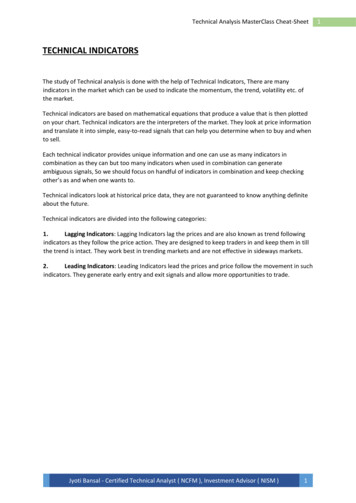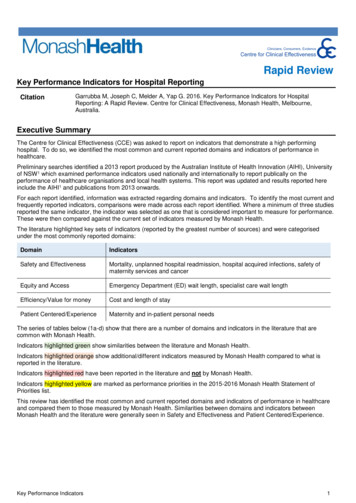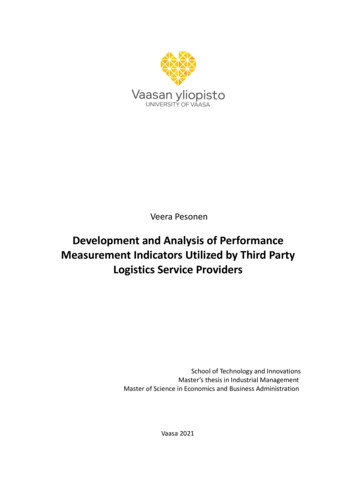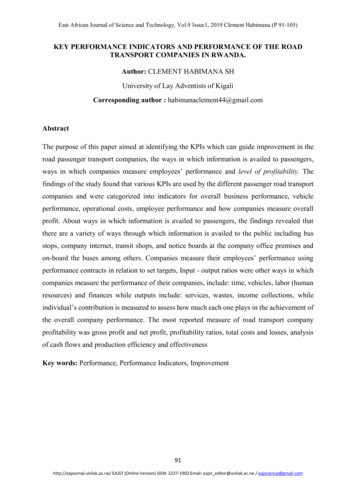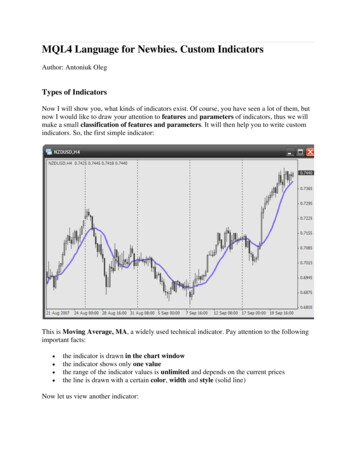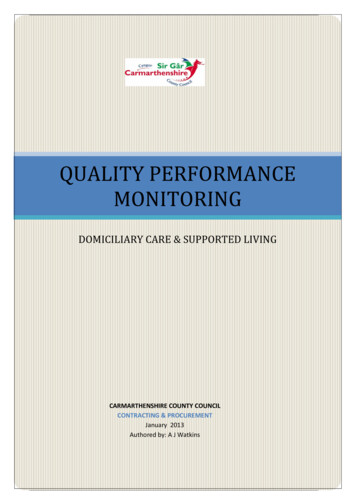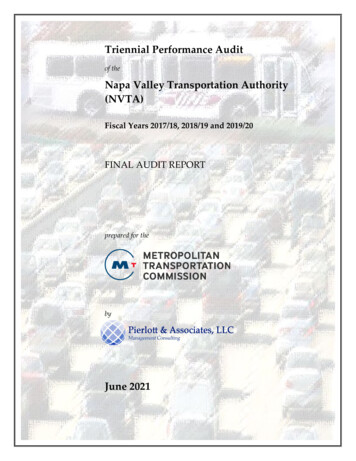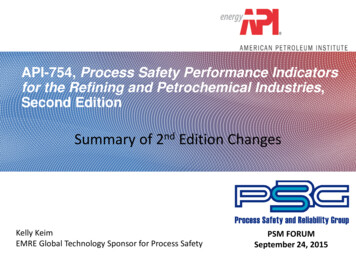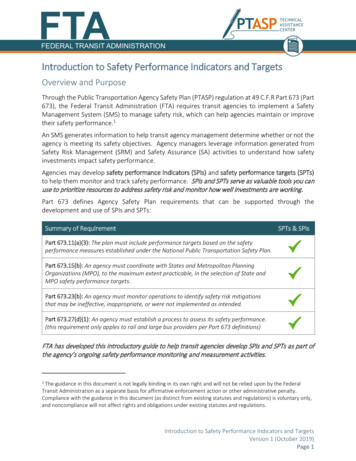
Transcription
FTAFEDERAL TRANSIT ADMINISTRATIONIntroduction to Safety Performance Indicators and TargetsOverview and PurposeThrough the Public Transportation Agency Safety Plan (PTASP) regulation at 49 C.F.R Part 673 (Part673), the Federal Transit Administration (FTA) requires transit agencies to implement a SafetyManagement System (SMS) to manage safety risk, which can help agencies maintain or improvetheir safety performance.1An SMS generates information to help transit agency management determine whether or not theagency is meeting its safety objectives. Agency managers leverage information generated fromSafety Risk Management (SRM) and Safety Assurance (SA) activities to understand how safetyinvestments impact safety performance.Agencies may develop safety performance indicators (SPIs) and safety performance targets (SPTs)to help them monitor and track safety performance. SPIs and SPTs serve as valuable tools you canuse to prioritize resources to address safety risk and monitor how well investments are working.Part 673 defines Agency Safety Plan requirements that can be supported through thedevelopment and use of SPIs and SPTs:Summary of RequirementSPTs & SPIsPart 673.11(a)(3): The plan must include performance targets based on the safetyperformance measures established under the National Public Transportation Safety Plan.Part 673.15(b): An agency must coordinate with States and Metropolitan PlanningOrganizations (MPO), to the maximum extent practicable, in the selection of State andMPO safety performance targets.Part 673.23(b): An agency must monitor operations to identify safety risk mitigationsthat may be ineffective, inappropriate, or were not implemented as intended.Part 673.27(d)(1): An agency must establish a process to assess its safety performance.(this requirement only apples to rail and large bus providers per Part 673 definitions)FTA has developed this introductory guide to help transit agencies develop SPIs and SPTs as part ofthe agency’s ongoing safety performance monitoring and measurement activities.1The guidance in this document is not legally binding in its own right and will not be relied upon by the FederalTransit Administration as a separate basis for affirmative enforcement action or other administrative penalty.Compliance with the guidance in this document (as distinct from existing statutes and regulations) is voluntary only,and noncompliance will not affect rights and obligations under existing statutes and regulations.Introduction to Safety Performance Indicators and TargetsVersion 1 (October 2019)Page 1
FTAFEDERAL TRANSIT ADMINISTRATIONSPIs and SPTs in PracticeHow can your agency use SPIs and SPTs?1. You can use them to see if you are meeting your overall safety objectives. If you operaterail transit service or if you are a large bus provider according to Part 673, FTA requiresyour agency to have a continuous improvement process to assess safety performance. Youshould evaluate your agency’s safety performance regularly and determine whether youshould change your safety performance targets when you update your Agency Safety Plan.2. You can use them to help you monitor the effectiveness of your safety risk mitigations.They can tell you whether or not action taken to address safety risk (your mitigation) isworking as intended.In practice, SPIs and SPTs can help your agency answer the question:“Are our safety activities (safety investment)achieving our safety objectives (desired safety performance)?”How Do I Develop SPIs and SPTs?Step 1: Know what you want to accomplish.Before you define SPIs and SPTs, you will want tomake sure everyone involved understands theassociated safety objective. Safety objectivescan refer to the formal safety objectives FTArequires you to define in your written statementof safety management policy, but more often inpractice refer to the intended safety outcome ofa safety risk mitigation.Before developing an SPI, make sure that you canclearly answer the following question:Safety objectives are brief, high-level,and non-quantifiable statements ofthe agency’s desired safetyoutcomes. They represent what youragency is trying to achieve.Part 673.23(a): A transit agency must have awritten statement of safety management policythat includes the agency’s safety objectives.“What are we trying to accomplish?”Let’s use a simple example to demonstrate this concept. Suppose your agency experiences agrowing number of injuries. Your agency’s leadership commits to addressing this issue. Thisbecomes a safety objective: “reduce injuries” – thereby focusing the investment of resources.Introduction to Safety Performance Indicators and TargetsVersion 1 (October 2019)Page 2
FTAFEDERAL TRANSIT ADMINISTRATIONStep 2: Ask, “Do we have the right data?”You cannot monitor or measure safety performance effectively without data. Without data, youmust rely solely on the knowledge of subject matter experts (SMEs). However, excess data orextraneous data collection can be detrimental and overwhelming. Data collection is mostbeneficial when it is targeted and driven by a purpose. Data needs to serve the agency toeffectively assess safety performance and to validate the effectiveness of safety risk mitigations.In a transit agency environment, it is important to leverage the knowledge of your agency’s SMEsto ensure you know what data is available and reliable for monitoring purposes.Step 3: Define the SPI.Think of an SPI as the indicator that you will watch while working to achieve your safety objective.Using our injury example from earlier, you might choose FTA-reportable injuries per vehiclerevenue mile (VRM) as your SPI. This is the data point you would watch to monitor your progresstoward your safety objective (reduce injuries).What makes a good SPI? An SPI is a measure or data point thatIt is clearly defined (explicit andyou will watch to monitor safetyunambiguous).performance.SMEs have weighed in to define it.It is measurable or quantifiable.It can be measured by data available to your agency.There are two common types of indicators used to support safety performance monitoring andmeasurement: lagging SPIs and leading SPIs.Lagging SPIs leverage data related to things that have already happened. Transit agencies definelagging SPIs using historical data of negative outcomes, such as accidents, incidents, andoccurrences. Examples of lagging SPIs include: The number of fire/smoke events in transit stations requiring evacuation per month.The number of traction power insulators involved in fire/smoke conditions per week.Leading SPIs measure conditions that have the potential to become or contribute to a negativeoutcome before the outcome occurs. Leading SPIs can be very valuable because they allow youto monitor precursors to events and offer the opportunity to act before something bad happens.An example of a leading indicator is: The number of defective traction power insulators reported through the employee safetyreporting program per week.Introduction to Safety Performance Indicators and TargetsVersion 1 (October 2019)Page 3
FTAFEDERAL TRANSIT ADMINISTRATIONStep 4: Define the SPT.An SPT should always include two keycomponents:1. The desired improvement in safetyperformance; and2. The amount of time for achieving theimprovement.An SPT is a quantifiable level ofimprovement from the present-day,baseline value of associated SPIs, tobe achieved over a specifiedtimeframe.Before you can define your SPT, you need to know your current (or baseline) safety performance.This will represent the starting line for your safety performance improvement.Remember our injury example? Before defining our SPT, we need to know the baseline for our SPI(our current rate of injuries). Based on a review of existing data, we determine that the agency isexperiencing 50 FTA-reportable injuries per 10 million VRM.Next, we need to ask, “what do we want to achieve?”Consulting data from peer agencies and our own historical data, we determine that a rate of 25injuries per 10 million VRM would be acceptable. So now we know where we want to go.Next, we need to ask, “how fast do we want to get there?”We decide that we would like to achieve our desired outcome within the next year.Now we can define our SPT: Reduce FTA-reportable injuries by 50% within one year.An SPT represents our predicted improvement in safety performance as a result of our safetyactivities (i.e., mitigations). The SPT, built on an appropriate SPI, allows us to know whether or notour safety investment has actually achieved our safety objective.Remember, A target doesn’t need to be perfect. Meeting or missing a target doesn’t need toautomatically trigger action; it will serve as an input to decision-making, not a replacement for it.Examples of SPIs and SPTsSafety Objective: Reduce passenger slip and fall events on vehicles.SPI 1: Number of passenger injuries from slip/fall events on vehicles per vehiclerevenue mile. (Lagging)SPT 1: Reduce the number of passenger injuries from slip/fall eventson vehicles per vehicle revenue mile by 10% over the next 12 months.Safety Objective: Reduce right-of-way (ROW) near miss events.Introduction to Safety Performance Indicators and TargetsVersion 1 (October 2019)Page 4
FTAFEDERAL TRANSIT ADMINISTRATIONSPI 1: Number of ROW near miss events per month. (Lagging)SPT 1: Reduce the number of ROW near miss events per month by25% over the next 12 months.SPI 2: Number of events when ROW workers did not have 15 seconds advancewarning to safely evacuate tracks per month. (Leading)SPT 2: Reduce the number of events where ROW workers did not have15 seconds advance warning to safely evacuate tracks per month by50% over the next 12 months.SPI 3: Percentage of ROW worker training courses completed on schedule eachmonth. (Leading)SPT 3: Increase the number of employee training courses completedon schedule each month to at least 95% over the next 6 months.Safety Objective: Implement an employee safety reporting programSPI 1: Percentage of high safety risk reports analyzed and forwarded toappropriate departments within one day of reporting. (Leading)SPT 1: Increase percentage of high safety risk reports analyzed andforwarded to appropriate departments within one day of reporting by10% over 3 months.SPI 2: Percentage of medium safety risk reports analyzed and forwarded toappropriate departments within three days of reporting. (Leading)SPT 2: Increase percentage of medium safety risk reports analyzed andforwarded to appropriate departments within three days of reportingby 10% over 3 months.SPI 3: Percentage of low safety risk reports analyzed and forwarded toappropriate departments within one week of reporting. (Leading)SPT 3: Increase percentage of low safety risk reports analyzed andforwarded to appropriate departments within one week of reportingby 10% over 3 months.Introduction to Safety Performance Indicators and TargetsVersion 1 (October 2019)Page 5
The plan must include performance targets based on the safety performance measures established under the National Public Transportation Safety Plan. Part 673.15(b): An agency must coordinate with States and Metropolitan Planning Organizations (MPO), to the maximum extent practicable, in the selection of State and MPO safety performance targets.


